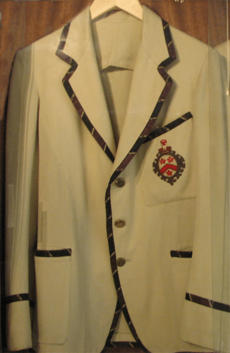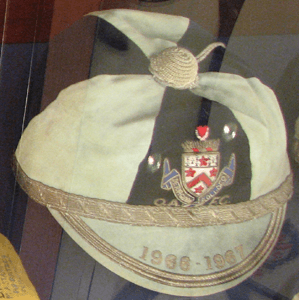Dulwich College facts for kids
Quick facts for kids Dulwich College |
|
|---|---|
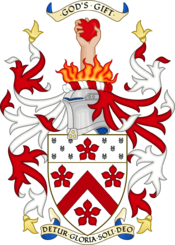 |
|
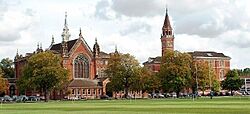 |
|
| Address | |
|
Dulwich Common, Dulwich
, SE21 7LD
England
|
|
| Coordinates | 51°26′22″N 00°05′03″W / 51.43944°N 0.08417°W |
| Information | |
| Type | Public school Private day and boarding school |
| Motto | Latin: Detur Gloria Soli Deo (Let Glory Be Given To God Alone) |
| Established | 1619 |
| Founder | Edward Alleyn |
| Local authority | Southwark London Borough Council |
| Department for Education URN | 100861 Tables |
| Chair | Peter Riddell |
| The Master | Joseph Spence |
| Gender | Boys |
| Age range | 2–19 |
| Enrolment | 1,820 (2018) |
| Capacity | 1,750 |
| Houses |
|
| Colour(s) | Royal blue and black |
| Publication | Alleynian |
| Affiliations |
|
| Alumni | Old Alleynians |
| Charity Commission. Dulwich College, registered charity no. 1150064. https://apps.charitycommission.gov.uk/Showcharity/RegisterOfCharities/SearchResultHandler.aspx?RegisteredCharityNumber=1150064. | |
Dulwich College is a private school for boys aged 2 to 19 in Dulwich, London, England. It is both a day school (where students go home after classes) and a boarding school (where students live at the school).
The school started in 1619 as the College of God's Gift. It was founded by Elizabethan actor Edward Alleyn to educate 12 poor students. The school grew significantly from 1857 and moved to its current location in 1870.
Students usually join Dulwich College in years 3, 7, 9, and 12. These correspond to ages 7, 11, 13, and 16. The college is divided into Junior, Lower, Middle, and Upper Schools. Dulwich College is a member of important school groups like the Headmasters' and Headmistresses' Conference and the Eton Group.
In the 2023 A-levels (exams taken at age 18), 64.8% of students achieved top grades (A*/A). The school is recognized as one of the best private schools globally and among the top 30 senior schools in the UK.
Contents
History of Dulwich College
1619: The College of God's Gift is Born
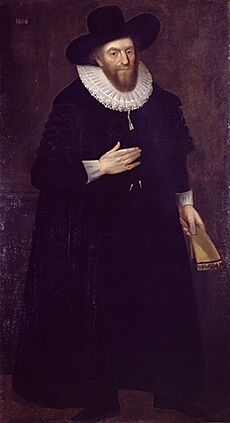
On June 21, 1619, the College of God's Gift was officially created in Dulwich. This happened when King James I signed the necessary documents. Even back then, people sometimes called it "Dulwich College."
Edward Alleyn, the founder, was a famous actor from the Elizabethan era. He performed in plays written by Christopher Marlowe at the Rose Theatre. Alleyn was also very wealthy, owning many properties, including theatres.
Around 1605, Alleyn bought the land in Dulwich. He soon thought about starting a college or hospital for poor people and to educate poor boys. Construction of a chapel, a schoolhouse, and twelve almshouses (homes for poor people) began in 1613 and finished in 1616. On September 1, 1616, the chapel was blessed by the Archbishop of Canterbury.
Alleyn faced some challenges from Francis Bacon, a powerful official, to get the college officially recognized. But Alleyn kept trying, and eventually, King James I signed the documents, making the foundation official.
The charity originally included a Master, a Warden, four teachers (called fellows), six poor men, six poor women, and twelve poor students (orphans from age six). These 30 people together owned Alleyn's land and property in Dulwich. The poor men, women, and students were chosen from four parishes connected to Alleyn.
Alleyn studied other schools like Winchester College to create the rules for his college. He stated that students could stay until they were eighteen and should be taught "good and sound learning" to prepare them for university or good jobs. He also said that the Master and Warden should always be unmarried and related to him, or at least share his last name. People from Dulwich could also send their boys to the school for a fee, as could children from outside Dulwich for a different fee.
For the next two centuries, the college faced financial problems and internal disagreements. The Archbishop of Canterbury, who was supposed to make sure the rules were followed, was often called in to help. The school struggled to fully achieve Alleyn's vision during this time.
However, some important Masters led the college. James Allen, a Master in 1741, gave the college six houses. The money from these houses helped start two small schools in Dulwich: one for boys and one for girls. This girls' school eventually became James Allen's Girls' School (JAGS).
In 1842, the Dulwich College Grammar School was created to educate poor boys from Dulwich and Camberwell. The boys from James Allen's Foundation moved to this new grammar school, leaving James Allen's school for girls only. The Old Grammar School building, designed by Sir Charles Barry, still stands today.
1857: A New Beginning for the School
On August 25, 1857, a new law called the Dulwich College Act 1857 changed the school. The "College of God's Gift" became "Alleyn's College of God's Gift." It was divided into two parts: one for education (the college) and one for charity (for the poor). The old Master, Warden, teachers, and servants were given pensions. However, Alleyn's wishes are still honored today, as sixteen pensioners (like the original poor brothers and sisters) live in the Old College. The Master continued to be the head of the new school.
The new Master, Reverend Alfred Carver, worked hard to make Dulwich College a top public school with high academic standards. He was the first Master not named "Alleyn" or "Allen." The educational part of the college was split into an "Upper" and "Lower" school. The "Upper school" was for boys aged 8 to 18, with a broad and detailed curriculum. This was the school people still called "Dulwich College." The "Lower school" was for boys aged 8 to 16, had lower fees, and was for children from working-class families. This Lower School included the boys from the grammar school.
1870: Moving to the New College Building
By the mid-1860s, Dulwich College's reputation had grown so much that many students wanted to join, leading to competitive entrance exams. In 1869, the Upper School moved to its current location, known as the "New College." The new college buildings, on 24 hectares (about 60 acres) of Dulwich Common, were designed by Charles Barry Jr.. The new college was officially opened on June 21, 1870, by the Prince and Princess of Wales.
The Lower School stayed at the Old College in Dulwich Village until 1887, when it moved to its own new building in East Dulwich.
During this time, the school's colors and the school magazine (The Alleynian) were established. School clubs like Debating and Natural Science also began. By 1882, when Canon Carver retired, Dulwich College had grown very quickly. It was known for its success in getting students into universities and for winning awards in various fields.
1882: Dulwich College Becomes Its Own School
Even with its great reputation, there was pressure to reorganize the college and use some of its money for other projects. Canon Carver, the Master, fought against this for many years and won an appeal in 1876.
In 1882, a new plan was finally accepted. This plan officially split the Upper and Lower schools into separate institutions. The Upper School became Dulwich College (officially for the first time), and the Lower School became Alleyn's School. Both schools remained part of the larger College of God's Gift charity, which also included James Allen's Girls' School and other schools.
Two groups of governors were created. The College Governors managed Dulwich College, the Chapel, and the Dulwich Picture Gallery. The Estates Governors managed the land and almshouses. This system still exists today. The Archbishop of Canterbury's role changed to an Honorary Visitor.
Canon Carver retired after this, having been the first headmaster appointed and retired by a special law. Arthur Herman Gilkes, who became Master in 1885, is said to have given the college its "soul" with his focus on learning and helping others. He started the College Mission in a poor part of Camberwell.
From 1903, students whose fees were paid by the London County Council were admitted. This "Dulwich College Experiment," led by Christopher Gilkes (Master from 1941 to 1953), helped save the college from financial trouble. It was a bit like the later state "Assisted Places Scheme." This led to a "renaissance" (a rebirth) of academic success for the college, especially in the late 1950s, when many students won awards to study at Oxford and Cambridge universities.
School Arms and Symbols
When Edward Alleyn founded the school, he was given a special coat of arms and crest. The school used this symbol until 1935, when it was decided that it belonged only to Edward Alleyn's family.
The new coat of arms granted to the school in 1935 was very similar. The flames in the crest represent learning. An arm holding a heart comes out of the flames. This symbolizes charity and Alleyn's kind intentions. It also reminds people of a famous speech by Alleyn, written by Ben Jonson, where he presented King James I with the "flaming heart of London" in 1604. The bottom part of the shield has a silver background with a chevron (a V-shape) dividing three red five-leafed flowers (cinquefoils).
Houses at Dulwich College
All students at Dulwich College belong to a "house." These houses help organize students for competitions and activities.
Boarding Houses: Where Students Live
Students who live at the school (boarders) belong to one of three boarding houses. Younger students (up to Year 11, age 16) live in The Orchard. Older students (Year 12 and 13, ages 17-18) live in either Ivyholme or Blew House.
When the college was reorganized in 1857, most students were day-boys. But there were also boarding houses, run by ladies in the village. Over time, the number of boarding houses has changed.
- Blew House: This is one of the two senior houses today. It moved to its current spot in the 1930s. It was the only house to stay open during World War II.
- Ivyholme: The second senior house, it also moved in the 1930s. It was damaged during World War II but reopened soon after.
- The Orchard: This is the only junior boarding house still open. It was also damaged in World War II but reopened near the end of the war.
- Elm Lawn: Famous writer P.G. Wodehouse once boarded here. After World War II, it became a junior house. In 1949, it became the Master's (headmaster's) home, which it still is today.
- Bell House: This old building became the Master's home in 1927. During World War II, it housed students from another school. Later, it became a junior boarding house, replacing Elm Lawn. In 1993, it was sold back to private owners.
- Carver House: This house was created during World War II by converting the cricket pavilion. It was named after Canon Carver but did not last long as a boarding house.
House Clubs and Colors
Boarding houses used to have their own sports teams and special colors. Students who earned these colors could wear unique ties and caps. For outstanding contributions, they might even get a house blazer.
Today, older students can join the Zodiac Club (for Ivyholme) or the Caerulean Club (for Blew House). Being a member allows them to wear a special tie. The tradition of house blazers mostly ended in 1970, except for the House Captain, who can wear a house blazer if they have earned full school colors.
Gordon Bowl Competition
The Gordon Bowl is a trophy for boarding houses. It was given to the college before World War II by a former student, A. G. Gordon. Originally, all four boarding houses competed for it. After World War II, only the senior houses, Blew House and Ivyholme, competed until 2017, when The Orchard was included again. It is still a competition today.
Day Houses: For Day Students
All day students belong to one of eight "day houses," also called "Athletic Houses." These houses were created in 1919 to improve sports at the college. They were named after famous Englishmen from the Elizabethan period.
Originally, there were six houses: Grenville, Marlowe, Spenser, Sidney, Drake, and Raleigh. Boarders were divided among the first four. In 1982, two more houses, Jonson and Howard, were added because the school had more students.
These houses compete in sports and cultural events like music, drama, chess, and debating. The "Cock House Shield" or "Cup" is awarded to the house that performs best across all competitions each year.
School Uniform and Colors
The uniform at Dulwich College depends on a student's house, sports teams, or if they have earned special school colors or become a prefect.
In 1863, the Master, Alfred Carver, set the uniform as a short tunic, Oxford mixture trousers, a rifle cap, and a dark cape for winter. Later, in 1883, the new Master, Welldon, made sure boys wore a uniform that looked similar to today's formal jackets.
The school colors, blue and black, are thought to be based on Marlborough College. Caps with blue ribbons were introduced in 1864, and the college arms were added in 1875. From this time, a system of colors began to reward achievements, especially in sports. Blazers were given for the first and second teams in major sports like rugby and cricket. Minor sports had blazer badges, caps, and ties. Boarding houses also had their own colors.
By 1909, there were many different caps and blazers. Special striped jackets for top athletes gave them privileges, like being able to go first through certain doors. The best rugby players could earn a rare rugby honors cap. The most famous item was the white blazer, displayed in the college's library. This was only given to students who were on both the Cricket 1st XI and Rugby 1st XV teams AND excelled in a minor sport like boxing or squash. Famous alumni like Trevor Bailey, an England cricketer, earned this blazer.
The uniform stayed mostly the same until the 1960s. Caps and straw hats (boaters) were common. Students would "cap" (touch their cap) to show respect. In the 1960s, caps and boaters became less common, and the variety of blazers was reduced.
Activities and Sports
Sports at Dulwich College
Dulwich College has a strong tradition of sports. The school captain and captains of various sports used to manage the games. Today, teachers are in charge of coaching.
Special colors were the first rewards for sporting achievement. These included blazers for top teams in rugby and cricket, and badges for minor sports. The white blazer was the most prestigious, given to exceptional athletes in both major and minor sports.
The college divides sports into Major and Minor. Rugby and cricket have always been major sports. In the 20th century, field hockey became a major sport. Soccer became a major sport in 2000. Many minor sports have been recognized for over a century, including athletics, Fives, shooting, boxing, tennis, swimming, gymnastics, and fencing. The school also has teams for golf, badminton, basketball, and more.
The school has excellent facilities, including a sports center, courts for many racquet sports, an athletic track, tennis courts, a swimming pool, and large playing fields.
Rowing Club
The school has an active rowing club, the Dulwich College Boat Club, started in 1991. The school has its own boathouse on the River Thames. The club has won several national championships, including at the 2001 British Rowing Championships, 2008 British Rowing Championships, 2014 National Schools' Regatta, and 2016 Schools' Head of the River Race.
Rugby Tradition
Rugby is a major sport in the autumn term, and Dulwich College has a strong reputation in it. The school's rugby tradition began in 1859 with a victory over City of London School. More than 30 former students have played rugby at an international level.
Three students have gone on to play for the British and Irish Lions. A famous team in 1909 was unbeaten and included five future international players. Between 2012 and 2014, Dulwich College won the Natwest Schools Cup three times in a row. In 2017, they made history by winning both the Schools Cup and the Champions Trophy, the highest level of school rugby.
Combined Cadet Force (CCF)
Dulwich College has a well-established Combined Cadet Force (CCF) program, running since 1859. Students can choose to join the Royal Navy, Army, or Royal Air Force sections, usually starting in Year 9. Since 2018, girls from James Allen's Girls' School can also join.
The CCF regularly goes on trips, including flight experiences and expeditions to places like the arctic or desert. The group has won gold medals in competitions like the Cadet Cambrian Patrol and the Air Squadron Trophy Competition multiple times.
Scouts Group
Dulwich College has a Scout Group, 25th Camberwell. It offers scouting for younger students in Years 4 & 5 (Cubs) and Years 6-9 (Scouts). There is also an Explorer Unit for older students in Years 10-13. The group was founded in 1929 and is run by school staff, former students, and parents.
Dulwich College Union and Clubs
Dulwich College has a large "union" for clubs and societies, with over 50 different groups. These clubs cover a wide range of interests, from Rocketry to History. Students in Years 12 and 13 often run these clubs, and their participation can count towards their The Duke of Edinburgh's Awards. Many clubs have their own special ties.
Debating Society
Debating is a very popular activity within the Dulwich College Union. The debating society meets during school terms and competes nationally and internationally. It includes students from Year 7 to 13 and has about 50 members.
The society has been very successful, winning the Oxford Union Debating Competition in 2014, 2015, and 2016. They also won the Cambridge Union Schools Debating Competition in 2014, 2015, and 2018, and the ESU (English Speaking Union) Schools Mace Debating Competition in 2014 and 2015. Dulwich College debaters have represented Team England and competed against other national teams around the world. This makes Dulwich College one of the top debating schools in the UK and globally.
School Magazine: The Alleynian
The official school magazine of Dulwich College is called The Alleynian. It is named after the school's founder, Edward Alleyn. The first issue of The Alleynian was published in 1873. Before that, the school had a magazine called the Dulwich College Magazine for School News and General Reading, which started in 1864 but only lasted for fourteen issues. Famous writer P. G. Wodehouse was once the editor of The Alleynian during his last year at the school.
Notable Former Students
Former students of Dulwich College are called "Old Alleynians," named after the school's founder, Edward Alleyn. This is often shortened to "O.A." in school publications. This term is different from "Alleyn's Old Boys," which refers to alumni of Alleyn's School. Students currently at the school are called Alleynians. Before about 1880, former students were known as Dulwichians.
Many famous people have attended Dulwich College, including explorer Sir Ernest Shackleton, writer Sir P G Wodehouse, author Raymond Chandler, former Governor of the Bank of England Sir Edward George, comedian Bob Monkhouse, author Michael Ondaatje, actor Chiwetel Ejiofor, actor Nicholas Galitzine, politician and broadcaster Nigel Farage, cricketer Trevor Bailey, writer C. S. Forester, architect C. F. A. Voysey, and comedian Paul Sinha.
Headmastership of Dulwich College
The head of Dulwich College is called The Master of Dulwich College. This title has been used since the school's founding in 1619. The original governing body of the College of God's Gift included a master, warden, and other assistants. The master was the most senior.
When the Dulwich College Act was passed in 1857, the old master, warden, and fellows were given pensions. However, the title of master continued for the head of the new upper school. The 1882 act removed the position of "undermaster" (deputy).
- Masters of Alleyn's College of God's Gift at Dulwich (both Upper and Lower Schools)
- Alfred James Carver (1858–1883)
- Masters of Dulwich College
- James Edward Cowell Welldon (1883–1885)
- Arthur Herman Gilkes (1885–1914)
- George Smith (1914–1928)
- Walter Reynolds Booth (1928–1941)
- Christopher H. Gilkes (1941–1953)
- C. Thomas (Deputy Master, served as Master for one year in 1953)
- Ronald Groves (1954–1966)
- Charles W. Lloyd (1966–1975)
- David A. Emms (1975–1986)
- Anthony C. F. Verity (1986–1995)
- Christopher Field (Acting Master in 1996)
- Graham G. Able (1997–2009)
- Joseph A. F. Spence (2009–2024)
In September 2024, Joseph Spence retired. Fiona Angel was appointed as Acting Master for the following year. Robert Milne is expected to become the new Master in September 2025.
College Collections
The school has a very large archive, especially with items related to drama and the arts. Much of this comes from Edward Alleyn's (the founder's) own library. Besides diaries kept by Alleyn and his partner Philip Henslowe, there are many other documents about the college.
The collection also includes 12 volumes of music by John Reading, two of the three volumes of First Folio Shakespeare plays, a Mercator Atlas, first editions of poetry by John Donne, Edmund Spenser, and Dryden, a Book of Hours from the 15th century, and even a copy of the first book printed in London in 1480.
Other interesting items held by the college include the James Caird, the lifeboat used by Ernest Shackleton on his incredible journey for survival to South Georgia in 1916. There are also sledges from his earlier Nimrod expedition.
Above the fireplace in the Masters' Library are two panels showing pietas (Duty) and liberalitas (Generosity). Edward Alleyn bought these in 1618 from Elizabeth I's state barge. They are believed to have originally come from Francis Drake's ship, the Golden Hinde.
See also
 In Spanish: Dulwich College para niños
In Spanish: Dulwich College para niños
- Alleyn's College of God's Gift
- Dulwich International College
- Dulwich College Beijing
- Dulwich College Seoul
- Dulwich College Shanghai
- Dulwich College Singapore
- Dulwich College Suzhou
- Dulwich International High School Suzhou
- Dulwich International High School Zhuhai






